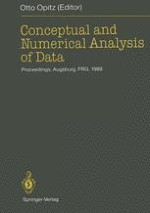The 13th conference of the Gesellschaft fUr Klassifikation e. V. took place at the Universitat Augsburg from April 10 to 12, 1989, with the' local organization by the Lehrstuhl fUr Mathematische Me thoden der Wirtschaftswissenschaften. The wide ranged subject of the conference Conceptual and Numerical Analysis of Data was obliged to indicate the variety of the concepts of data and information as well as the manifold methods of analysing and structuring. Based on the received announcements of papers four sections have been arranged: 1. Data Analysis and Classification: Basic Concepts and Methods 2. Applications in Library Sciences, Documentation and Information Sciences 3. Applications in Economics and Social Sciences 4. Applications in Natural Sciences and Computer Sciences This classification doesn't separate strictly, but it shows that theo retic and applying researchers of most different disciplines were disposed to present a paper. In 60 survey and special lectures the speakers reported on developments in theory and applications en couraging the interdisciplinary dialogue of all participants. This volume contains 42 selected papers grouped according to the four sections. Now we give a short insight into the presented papers. x Several problems of concept analysis, cluster analysis, data analysis and multivariate statistics are considered in 18 pa pers of section 1. The geometric representation of a concept lattice is a collection of figures in the plane corresponding to the given concepts in such a way that the subconcept-superconcept-relation corresponds to the containment relation between the figures. R.
